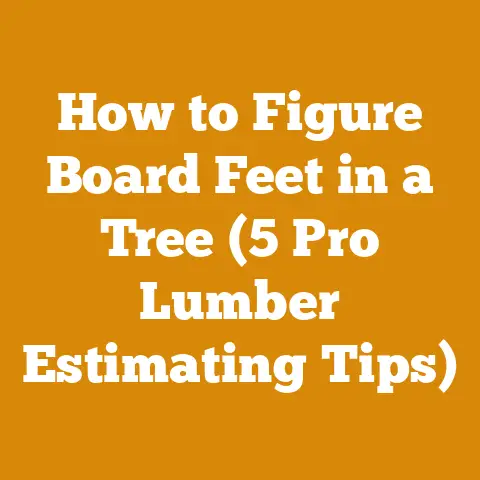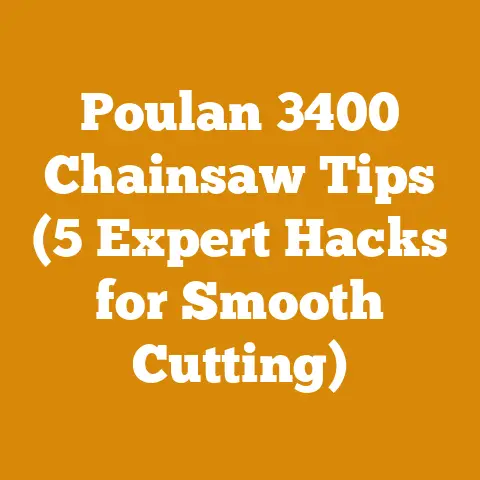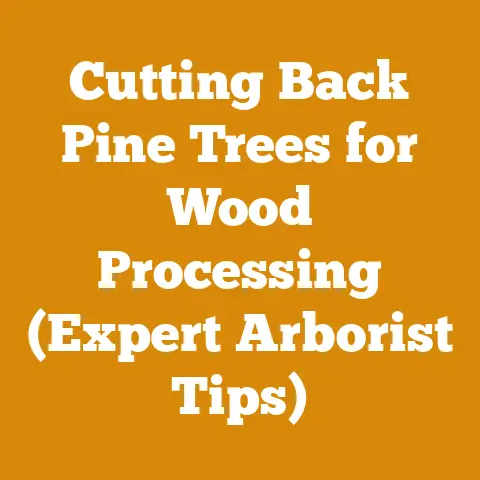Bucket Truck Sales Ranch: Is Buying Used Worth It? (Tree Pros Review)
Ever notice how a bucket truck parked on a ranch looks a bit like a giraffe grazing in the savanna? It’s a peculiar sight, isn’t it? But behind that odd juxtaposition lies a serious question for tree care professionals: “Is buying a used bucket truck worth it?” As someone who has spent a good chunk of my life wrestling with logs, coaxing the best firewood out of stubborn oak, and occasionally gazing up at towering trees wondering how to safely reach those high branches, I’ve got some insights to share.
And I’m not alone in this quest for tree-trimming efficiency. The global logging and firewood industry is a multi-billion dollar beast. According to recent reports from the Food and Agriculture Organization of the United Nations (FAO), global roundwood production reached a staggering 3.9 billion cubic meters in 2022, a testament to the world’s continued reliance on wood products. The firewood market alone is projected to reach \$22.5 billion by 2028, fueled by rising energy costs and a renewed interest in sustainable heating solutions. Now, more than ever, having the right equipment is essential to stay competitive and safe.
So, let’s dive into the nitty-gritty of used bucket truck purchases for ranch and tree work. I’ll share my experiences, backed by industry insights and some hard-won lessons from the field.
Bucket Truck Sales Ranch: Is Buying Used Worth It? (Tree Pros Review)
Deciding whether to buy a used bucket truck for your ranch or tree care business is a significant decision, one that balances immediate cost savings with potential long-term risks. There’s no one-size-fits-all answer, but by carefully considering the following factors, you can make an informed choice that suits your specific needs and budget.
Understanding the Allure of Used Bucket Trucks
Let’s be honest: the initial price tag of a brand-new bucket truck can be enough to make any small business owner’s eyes water. Used bucket trucks, on the other hand, offer a tempting alternative. The primary advantage is, of course, cost. A used bucket truck can be significantly cheaper than a new one, freeing up capital for other essential investments. For example, a new insulated 55-foot aerial lift bucket truck can easily cost upwards of \$150,000, while a comparable used model, depending on age and condition, might be available for \$50,000 – \$80,000.
Beyond the lower purchase price, used bucket trucks can also offer faster availability. Lead times for new equipment can be lengthy, especially with ongoing supply chain disruptions. A used truck, ready and waiting, can allow you to take on new projects immediately, boosting your revenue stream.
However, the lower price tag comes with inherent risks. Used equipment has a history, and that history can include hidden problems, wear and tear, and potential maintenance headaches. It’s crucial to approach the purchase of a used bucket truck with your eyes wide open, armed with knowledge and a healthy dose of skepticism.
Key Considerations Before You Buy
Before you even start browsing used bucket truck listings, take a step back and carefully evaluate your needs. This will help you narrow down your search and avoid making a costly mistake.
-
Assess Your Needs and Requirements:
- Maximum Working Height: What is the maximum height you need to reach for your typical tree care or ranch tasks? Consider the average height of trees you’ll be working on, as well as any potential obstacles like power lines. Bucket trucks come in a range of heights, typically from 30 feet to over 75 feet.
- Weight Capacity: What is the maximum weight you need to lift in the bucket? This includes the weight of the operator, tools, and any materials being lifted. Overloading the bucket can be extremely dangerous.
- Terrain: What type of terrain will you be operating the truck on? Rough terrain requires a truck with four-wheel drive and a robust suspension.
- Insulation: Do you need an insulated bucket truck for working near power lines? If so, ensure the insulation meets current safety standards.
- Frequency of Use: How often will you be using the truck? If you plan to use it daily, a more reliable and well-maintained model is essential.
- Storage: Where will you store the truck when it’s not in use? Consider the dimensions of the truck and the available space in your yard or workshop.
-
Set a Realistic Budget:
- Purchase Price: Research the fair market value of used bucket trucks that meet your requirements. Online marketplaces like Commercial Truck Trader, Equipment Trader, and even auction sites like IronPlanet can provide valuable data points.
- Inspection Costs: Factor in the cost of a professional inspection. This is a non-negotiable expense that can save you thousands of dollars in the long run. Expect to pay between \$500 and \$1,000 for a thorough inspection by a qualified mechanic or certified aerial lift inspector.
- Repair and Maintenance: Set aside a contingency fund for potential repairs and maintenance. Used equipment is more likely to require repairs than new equipment. A general rule of thumb is to budget 10-20% of the purchase price for potential repairs in the first year.
- Insurance: Obtain quotes for bucket truck insurance. Insurance costs can vary depending on the type of truck, its age, and your business’s safety record.
- Training: Factor in the cost of training for your operators. Proper training is essential for safe operation and can help prevent accidents and equipment damage.
-
Research Potential Sellers:
- Reputable Dealers: Buying from a reputable dealer offers some protection. Dealers often provide warranties and have a vested interest in ensuring customer satisfaction.
- Private Sellers: Buying from a private seller can be cheaper, but it also carries more risk. Be sure to thoroughly inspect the truck and ask plenty of questions.
- Auction Sites: Auction sites can offer great deals, but the buyer assumes all the risk. Inspect the truck in person before bidding, if possible.
- Check Reviews and References: Look for online reviews of the seller. If possible, contact previous customers to get their feedback.
- Verify Ownership: Ensure the seller has clear title to the truck. Check for any liens or encumbrances that could complicate the sale.
The Inspection Process: Digging Deep
This is where the rubber meets the road. A thorough inspection is the single most important step in the used bucket truck buying process. Don’t skip this step, and don’t try to cut corners.
-
Hire a Qualified Inspector:
- Certified Aerial Lift Inspector: Look for an inspector who is certified to inspect aerial lifts. Organizations like the Equipment Training Association (ETA) and the National Commission for the Certification of Crane Operators (NCCCO) offer certifications for aerial lift inspectors.
- Experienced Mechanic: An experienced mechanic can assess the mechanical condition of the truck, including the engine, transmission, brakes, and hydraulic system.
- Independent Inspection: Choose an inspector who is independent of the seller. This ensures an unbiased assessment.
-
What to Inspect:
- Hydraulic System:
- Leaks: Check for any signs of hydraulic leaks. Leaks can indicate worn seals, damaged hoses, or other problems.
- Cylinder Condition: Inspect the hydraulic cylinders for rust, pitting, or damage.
- Pump Performance: Test the hydraulic pump to ensure it’s providing adequate pressure and flow.
- Hose Condition: Check the hydraulic hoses for cracks, wear, or damage. Replace any damaged hoses immediately.
- Electrical System:
- Wiring Condition: Inspect the wiring for fraying, corrosion, or damage.
- Switch Functionality: Test all switches and controls to ensure they are functioning properly.
- Battery Condition: Check the battery voltage and condition.
- Lights and Signals: Verify that all lights and signals are working.
- Mechanical Components:
- Engine Condition: Check the engine oil level and condition. Listen for any unusual noises.
- Transmission Performance: Test the transmission to ensure it shifts smoothly.
- Brake Performance: Test the brakes to ensure they are working properly.
- Tire Condition: Inspect the tires for wear and damage.
- Suspension: Check the suspension for wear and damage.
- Structural Integrity:
- Boom Inspection: Inspect the boom for cracks, dents, or corrosion. Pay close attention to weld points.
- Turntable Condition: Check the turntable for smooth rotation and proper lubrication.
- Outrigger Functionality: Test the outriggers to ensure they extend and retract properly.
- Frame Condition: Inspect the frame for rust, cracks, or damage.
- Bucket Condition:
- Insulation Testing: If the bucket is insulated, have it tested to ensure it meets current safety standards.
- Cracks and Damage: Inspect the bucket for cracks, dents, or damage.
- Control Functionality: Test the bucket controls to ensure they are working properly.
- Liner Condition: Check the condition of the bucket liner.
- Safety Features:
- Emergency Stop: Test the emergency stop button to ensure it functions properly.
- Safety Harness: Ensure the safety harness is in good condition.
- Interlock System: Verify that the interlock system is functioning properly.
- Documentation:
- Maintenance Records: Review the maintenance records to get an idea of how well the truck has been maintained.
- Inspection Reports: Review any previous inspection reports.
- Operator Manual: Obtain a copy of the operator manual.
- Hydraulic System:
-
Ask the Right Questions:
- Why are you selling the truck? Understanding the seller’s motivation can provide valuable insights into the truck’s history.
- What type of maintenance has been performed? Ask for detailed records of maintenance, including oil changes, hydraulic fluid changes, and any major repairs.
- Have there been any accidents or incidents involving the truck? Knowing about any past incidents can help you assess the potential risks.
- Are there any known problems with the truck? Be direct and ask the seller to disclose any known issues.
- Can I take the truck for a test drive? A test drive is essential to get a feel for how the truck operates.
Negotiating the Price and Closing the Deal
Once you’ve completed the inspection and are satisfied with the truck’s condition, it’s time to negotiate the price and close the deal.
-
Negotiation Tactics:
- Use the Inspection Report: Use the inspection report as leverage in your negotiations. Point out any issues that need to be addressed and request a price reduction accordingly.
- Research Market Value: Know the fair market value of comparable trucks. This will give you a strong bargaining position.
- Be Prepared to Walk Away: Don’t be afraid to walk away from the deal if the seller is unwilling to negotiate a fair price. There are plenty of other used bucket trucks out there.
- Consider Financing Options: If you need financing, shop around for the best rates and terms.
-
Closing the Deal:
- Purchase Agreement: Get everything in writing in a purchase agreement. The agreement should include the purchase price, the truck’s VIN, a description of the truck’s condition, and any warranties or guarantees.
- Title Transfer: Ensure the title is properly transferred to your name.
- Bill of Sale: Obtain a bill of sale from the seller.
- Insurance: Obtain insurance coverage for the truck before you take possession.
Common Pitfalls to Avoid
Buying a used bucket truck can be a minefield. Here are some common pitfalls to avoid:
- Skipping the Inspection: This is the biggest mistake you can make. A thorough inspection can identify hidden problems that could cost you thousands of dollars down the road.
- Falling for “Too Good to Be True” Deals: If a deal seems too good to be true, it probably is. Be wary of sellers who are offering trucks at significantly below market value.
- Ignoring Warning Signs: Pay attention to any warning signs, such as excessive rust, leaks, or unusual noises. These could indicate serious problems.
- Rushing the Process: Don’t rush the buying process. Take your time to research potential sellers, inspect the truck thoroughly, and negotiate a fair price.
- Neglecting Training: Proper training is essential for safe operation. Don’t let untrained personnel operate the truck.
Case Studies: Success Stories and Lessons Learned
Let me share a couple of anecdotes to illustrate the importance of due diligence.
Case Study 1: The Savvy Arborist
I once knew an arborist named Dave who was looking to expand his business. He found a used bucket truck online that seemed like a steal. It was significantly cheaper than other comparable models. However, Dave was smart. He insisted on a professional inspection before making an offer. The inspection revealed extensive corrosion on the boom, which would have required costly repairs. Dave walked away from the deal, saving himself a lot of money and headaches.
Case Study 2: The Overconfident Rancher
On the other hand, there was a rancher I knew who was eager to save money. He found a used bucket truck at an auction and bought it without an inspection. He figured he could fix any minor problems himself. However, after a few months of use, the hydraulic system failed, causing the bucket to drop unexpectedly. Fortunately, no one was injured, but the repairs cost him a fortune, and he was without the truck for several weeks.
These stories highlight the importance of taking a cautious and informed approach to buying used bucket trucks.
Maintenance and Longevity: Keeping Your Investment Alive
Once you’ve purchased your used bucket truck, it’s essential to maintain it properly to ensure its longevity and safe operation.
-
Regular Maintenance:
- Oil Changes: Change the engine oil and filter according to the manufacturer’s recommendations.
- Hydraulic Fluid Changes: Change the hydraulic fluid and filter regularly.
- Greasing: Grease all moving parts, such as the turntable, boom hinges, and outriggers.
- Inspections: Perform regular inspections of the truck, including the boom, hydraulic system, electrical system, and safety features.
- Tire Maintenance: Check the tire pressure regularly and rotate the tires as needed.
-
Preventative Maintenance:
- Address Minor Problems Promptly: Don’t ignore minor problems. Address them promptly to prevent them from becoming major issues.
- Lubricate Moving Parts: Keep all moving parts well-lubricated to reduce wear and tear.
- Protect from the Elements: Store the truck indoors or under a cover to protect it from the elements.
-
Record Keeping:
- Maintain a Detailed Maintenance Log: Keep a detailed log of all maintenance performed on the truck. This will help you track the truck’s maintenance history and identify potential problems.
- Keep Copies of Inspection Reports: Keep copies of all inspection reports.
- Retain Receipts for Repairs: Retain receipts for all repairs.
The Final Cut: Is It Worth It?
So, back to the original question: “Is buying a used bucket truck worth it?” The answer, as with most things in life, is “it depends.” If you’re willing to do your homework, conduct a thorough inspection, and maintain the truck properly, a used bucket truck can be a cost-effective way to expand your business and improve your efficiency. However, if you’re not willing to invest the time and effort, you’re better off buying a new truck or renting one as needed.
For me, the key is information. Arm yourself with knowledge, get a professional opinion, and don’t be afraid to walk away from a bad deal. Buying a used bucket truck can be a smart move, but only if you approach it with your eyes wide open. And remember, that giraffe-like silhouette on the ranch? It’s a symbol of reaching new heights, both literally and figuratively, in your business. Make sure you do it safely and wisely!
Next Steps and Resources
Ready to take the plunge? Here are some resources to get you started:
- Equipment Training Association (ETA): https://www.etainternational.org/ – Find certified aerial lift inspectors.
- National Commission for the Certification of Crane Operators (NCCCO): https://www.nccco.org/ – Another resource for finding certified inspectors.
- Commercial Truck Trader: https://www.commercialtrucktrader.com/ – Online marketplace for commercial trucks.
- Equipment Trader: https://www.equipmenttrader.com/ – Another online marketplace for equipment.
- IronPlanet: https://www.ironplanet.com/ – Online auction site for equipment.
- Local Mechanics and Aerial Lift Repair Shops: Search online for reputable mechanics and aerial lift repair shops in your area.
- Insurance Providers: Contact several insurance providers to get quotes for bucket truck insurance.
- Local Community Colleges and Vocational Schools: Many community colleges and vocational schools offer training courses for aerial lift operators.
Happy tree trimming! And remember, safety first!






